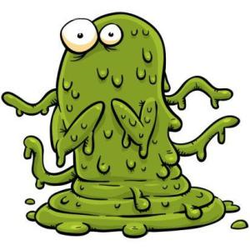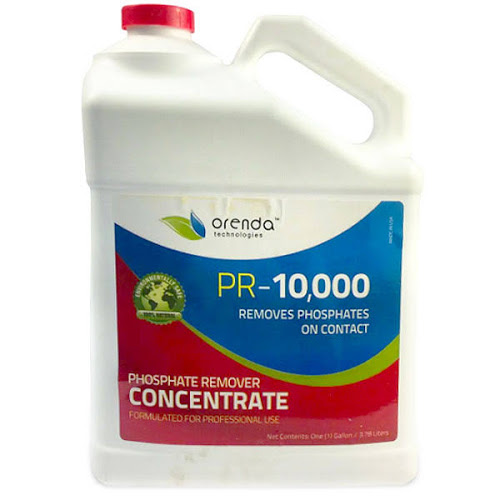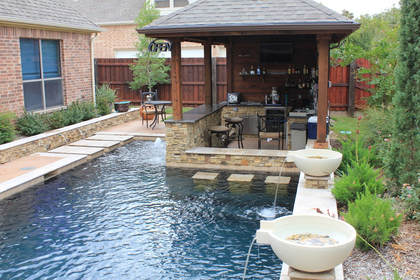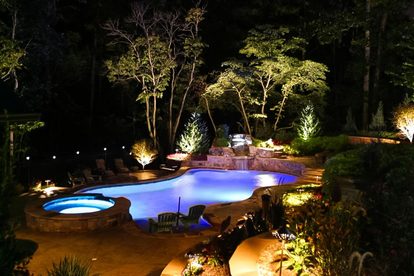|
What are Phosphates? Phosphates are chemical compounds that contain phosphorus. In addition to phosphorus, phosphates contain oxygen and sometimes hydrogen. Phosphates are a biological building block that is constantly being introduced to your pool water and nourishing algae. Phosphorus is a primary food source for aquatic plants including all types of algae. Phosphate compounds are broken down into their simplest form, orthophosphates, in one of the following three ways: Oxidation (converting compounds into oxides) Hydrolysis (decomposition by water, and Enzymatic digestion. Regardless of how it happens, if phosphates are allowed to remain present in pool or spa water they will be reduced to orthophosphates, which are the only form of phosphates that algae can digest. Orthophosphate levels should remain below 100-125 ppb (parts per billion). Once levels exceed 200 ppb, algae becomes increasingly resistant to sanitizers, including chlorine shock. Excessive levels of orthophosphate, such as 1,000 ppb or more, should be brought under control with a phosphate remover such as Natural Chemistry Phos-free or Bio-dex Phosphate remover plus. Phosphates are the most overlooked chemical test performed on a pool. Most 5 and 7 point dip test strips do not test for phosphate. Many pool owners don’t know about phosphates until it’s too late. Phosphate levels should be measured at least once a month. Sources of Phosphates The largest source of phosphates entering your pool come from the public water systems. Municipal water treatment plants commonly add phosphates to the drinking water as a corrosion inhibitor to prevent the leaching of lead and copper from pipes and fixtures. Inorganic phosphates (e.g., phosphoric acid, zinc phosphate, and sodium phosphate) are added to the water to create orthophosphate, which forms a protective coating of insoluble mineral scale on the inside of service lines and household plumbing. The coating serves as a liner that keeps corrosion elements in water from dissolving some of the metal in the drinking water. As a result, lead and copper levels in the water will remain low. The key to ensuring that orthophosphate reduces lead and copper levels, is for Public water systems to maintain proper orthophosphate levels. The health effects of drinking water with phosphates are not known. The Food and Drug Administration (FDA) has issued a report on the toxicology of inorganic phosphates as food ingredients. The FDA considers phosphates as a food additive to be "generally recognized as safe." The challenge with phosphates is that they are constantly being introduced into your swimming pool water. They are found in lawn and garden fertilizers, decaying vegetation, municipal water, cosmetic items on bathers, and even other pool chemicals. This means a fresh batch of phosphates enter your water when any of the following occur:
How to determine if you have a high phosphate level Use phosphate specific test strips. These strips are highly accurate and measure orthophosphate levels in 10 seconds. They have the widest testing range available on the market, at 0 – 6,000 ppb. (parts per billion). Water tests should be conducted weekly during peak swimming season and monthly during the off-season. The best part – this test kit only costs about $15.00 which is money you will save on shock and excess sanitizers to clear up algae blooms caused by high phosphate levels.  Why are phosphates bad Sixty percent of pool owners experience two full algae blooms every season. So, what causes these blooms and how can we prevent them. Phosphates are algae food they are needed to complete the photosynthesis process and promote algae blooms, once algae starts to bloom the available chlorine in your pool is consumed at an alarming rate as it tries to fight the algae. With no available chlorine to sanitize your pool it becomes helpless and starts to turn green and turbid specially in the warm summer months, Algae loves to thrive in warm dark waters. Phosphates plus low chlorine equals disaster.  How do you get rid of Phosphates There is no amount of chlorine that will kill phosphates. Special chemicals are needed to trap and reduce the level of the phosphates from swimming pool water. Phosphates can never be completely removed, but can be managed at a low level. This process typically takes two service visits to complete in full. Our first visit we brush down all walls and remove all debris from the baskets. We need to insure that there is proper flow with your equipment in order for the treatment to work correctly. If your filter is in need of cleaning we will recommend doing this before we start the treatment. We then add our chemicals to the water of your pool. The amount of chemicals that we use is determined by the amount of water the pool carries. These chemicals need to circulate in your system for the next 24 hours. Pool Phosphate Removal Tips:
How to prevent Phosphates from building up to a dangerous level
It is important to remember that phosphate removal is a preventative measure, if you have active algae present in the pool, treat it with chlorine shock and algaecide first, then follow up with a phosphate remover to prevent reoccurrence. As algae die, they release phosphates in to the water, making it more likely that algae will return, creating a vicious cycle of expensive to treat algae bloom after algae bloom.
As a swimming pool owner, you are guaranteed to run into some sort of problem with your pool from time to time. With regular maintenance and inspection, you can usually catch problems in the beginning stages before they become bigger more expensive problems. Your pool is fun, your pool is also an investment and requires maintenance. Regular routine swimming pool maintenance preferably by a professional is advised to prolong the life of your swimming pool. A large majority of pool problems are caused by lack of maintenance or improper maintenance. EXCESSIVELY ROUGH POOL SURFACE
This can be caused by many different things, the most common being poor water chemistry over a prolonged period of time. Concrete and pebble pools can have different finishing techniques and materials used which can also cause the surface to feel rough on your feet. Improperly balanced pH, improper alkalinity aggressive fill water, acid rain, high calcium hardness in the water, improper pool plaster starts up techniques, craze cracks, plaster delamination pitting, and calcium nodules are all possible scenarios that would cause a rough pool surface, this is why it’s so important to have your pool and it’s chemistry monitored and adjusted weekly by a pool professional who is trained and educated to look out for and correct these issues before they becoming big expensive problems. STRUCTURAL CRACKING A separation or crack in plaster and or concrete shell of the pool. Most commonly due to ground movement and improper design and or improper construction techniques. A swimming pool must be engineered and constructed to withstand unstable or expansive soil and built to the specifics of the soil sample that should be obtained and analyzed prior to construction. If not built in accordance to the engineering or according to the design a pool may structurally fail and leak water. PLASTER CRACKING & DELAMINATION small hairline plaster surface cracking referred to as craze cracking is most commonly due to improper application of the swimming pools plaster surface and an improper mix of the surface plaster. Most commonly too much calcium carbonate added to the mix which causes shrinkage of the plaster. This calcium is added to the plaster to increase its drying time and hardness. These surface cracks can promote algae growth, staining, and produce calcium nodules eventually resulting in the need to completely remove and replace the swimming pools surface. DISCOLORATION / MOTTLING (blotchy pool surface) Due to swimming pool plaster’s porous nature it is susceptible to staining. Pauses while filling the pool can leave a ring around the waterline, improper trawling techniques while the plaster is being installed, improper water chemistry, filling a pool too soon, improper mix of plaster being applied can all cause spotting and mottling in your pool. There are also many many different factors and causes of staining, from organic material such as leaves and dirt sitting on the pools plaster for a period of time, metal stains from fill water and improperly balanced water chemistry, copper from plumbing and heater elements, foreign objects being left on the pools surface. Sequestrants and stain removers can be used to effectively treat surface staining. ALGAE / GREEN POOL Probably the most common problem pool owners are familiar with, most commonly due to improper circulation, not enough circulation and or improper water chemistry balance, low sanitizer. Using a chlorine based shock and elevating the chlorine level 3x-5x the normal and a clean filter will solve this problem. CLOGGED FILTER / LOW CIRCULATION As your filter does its job it builds up pressure by trapping the dirt and organic waste in the filter, eventually it can’t filter anymore and needs taken apart cleaned and recharged. Don’t worry this is a good thing. A normal filter on a normal size pool should be cleaned and recharged 3-4x a year CLOUDY / TURBID WATER I’d say cloudy turbid water is one of the trickiest of problems to diagnose, could be cause by a dirty filter, rain, low chlorine, heavy use, usually resolved within a couple hours with proper treatment. This problem usually arises after heavy rains dilute the pools chemistry or the first couple weeks of summer when the summers hot sun starts to evaporate the free available chlorine in your pool. Cyanuric acid (conditioner) is needed in the warm months to protect the pools chlorine reserve and stop the suns UV rays from zapping your chlorine right out of your pool. The solution is to maintain 50-70ppm cyanuric acid and 3-5ppm chlorine level. A cloudy looking pool is the pools way of telling you something is unbalanced asking you for help before it gets really bad. Growing up in the 70s backyard barbeque block parties and spending all day and evening in your backyard was the thing to do. Groups of friends and neighbors would migrate from home to home weekly Almost everyone had a swimming pool, everyone brought something their wives cooked. Everyone knew their neighbors, we all got along. We mowed our own laws, we cleaned our own pools. Life moved a little slower back then. Believe it or not there was a time before cable television, iPhones, iPads, x-box’s and hanging out at Starbucks on your laptop. The humble backyard was once thought of as a concrete landing pad for a barbeque and a tranquil patch of grass where the kids could run freely and busy themselves playing all day while the parents had a family or neighborhood barbeque and adult time. Fast forward 3 decades. Oh how times have changed, backyards are beginning to reflect one’s dedication to the environment again. Today’s backyard is now expected to serve as a playground, waterpark, gourmet kitchen for the family chef, dining facility, and the much needed meditative retreat. The sounds of flowing water and the warmth of the sun. A beautiful backyard is of little value if guests have no place to sit. I have noticed a resurgence in cushioned plush backyard patio furnishings, lounges, even floating armada’s. Light blue’s and red’s and oranges have become popular colors. Many backyard oasis I’ve run into possess reclaimed wood and eco-friendly pieces such as coffee tables, side tables and planter boxes full of fresh homegrown vegetables. I think HGTV has been influential for many homeowners in this aspect. Repurposed and reclaimed items transformed to their new purpose. What would a backyard oasis be without the ever popular grill or outdoor kitchen. Everyone these days is somewhat of a barbeque enthusiast and the backyard typically reflects that primary purpose. No well-dressed backyard can go without the perfect barbeque grill. Many homeowners are switching to pellet grills, these typically heat up faster than typical charcoal gas and wood grills. Many homeowners that build an outdoor kitchen don’t stop at the gas grill, many accessories come along with it, Gas side burners, mood Lighting, electrical outlets, wine and beer chillers, sinks with running water, (hot and cold) warming trays, storage drawers, refrigerators, and lots of counter space for prep work, a recent popular choice for counters has been polished concrete. I attribute this desire for outdoor kitchens to homeowners desires to create a complete outdoor living experience a place where they can cook, eat, play, relax, read, watch tv or movies, or the game, and soak in the spa, a major extension of their home.  One can-not simply complete their backyard oasis without Shade, structures, and bar top counters, a place for everyone to get together and hang out a place for family and friends to sit and relax with drinks after a barbeque or swim party. Spring and summer make up the prime season for backyard enjoyment. These seasons also bring high temperatures, lots of sun and potential for sunburn. Many homeowners are investing in elaborate equipment to bring shade to their oasis. Not only to beat the heat but also to add to the design element of the house and backyard. Some choose a simple but elaborate umbrella, cantilever umbrellas are a popular favorite to remove the pole from line of site between guests. Shade sails are another trending popular choice among backyards. These premade canvas covers can be tensioned between structures such as trees and home walls and fences. My favorite shade structure is the Pergola. A shade structure that offers more than just shade, it offers style and aesthetics. Modern pergolas are not even wood anymore, they are Aluma-wood, aluminum that looks like real wood but fairs better in the outdoor elements and is less maintenance and upkeep does not require annual staining and waterproofing. The most elaborate of all shade structures is to build out the roof of your house into a covered patio. A shingled structure running the entire length of the house adds shade and value to your home.  Last but certainly not least we come to lighting, the element that makes things pop, the ahhhhhhhhh factor. LED lighting gives homeowners unlimited abilities with color and ambiance of which most LED lights are now “smart” lights and can be controlled from smart devices such as your smart phone or home automation device. Dimmable and programmable these are a favorite among homeowners with pre-programmed automation “dusk” settings. Many homeowners are also adding gas and electric space heaters to their backyard to be able to enjoy year round when the temperatures start to drop. The bottom line is homeowners are putting an awful lot of time and money into creating the perfect backyard oasis, so it’s no surprise that they are willing to go great lengths to get as much bang for their buck and utilize as much space as possible at the same time increasing the value and appeal of their backyard. |
AuthorWrite something about yourself. No need to be fancy, just an overview. Archives
August 2018
Categories
All
|
